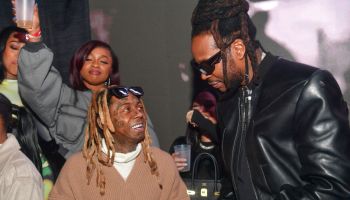
Source: Dominique Charriau / Getty
I waited till this morning to write this because I needed to see for myself before jumping on any bandwagons or any conclusions that weren’t my own.
I had seen the pictures, read the articles accusing the lingerie fashion company of cultural appropriation, but I wanted to see and experience it for myself. Because maybe, just maybe, I would see it as something different.
In full transparency, I’ve watched the Victoria’s Secret Fashion Show once or twice before. As a womanist, I don’t see anything wrong with women consciously participating in what some would deem the “objectification” of their bodies. And while the lack of diverse body types (and diversity in general) in the Victoria’s Secret shows and ad campaigns are indeed problematic, it’s not my place to tell anyone what they can and cannot do with their bodies.
I knew all this going into the opening credits and still tried to remain neutral and keep an open mind until I saw the show as a whole. But after Elsa Hosk turned the corner fully entwined from her waist to her back in a Chinese dragon, I found myself involuntarily reaching for my laptop to record my thoughts and feelings.
Because here’s the real deal that all the lights, all the glitter, all the glam — and yes, even all the Gaga — can’t mute: there’s something about this opening set that doesn’t sit right if you’re watching it through a lens of color.
And maybe perhaps if this argument was a singular event, there wouldn’t be such harsh and immediate backlash. But it’s not the first time the lingerie fashion giant has been accused of appropriating cultures.
In 2012, Victoria’s Secret thought nothing of sending Karlie Kloss in a full native people’s headdress down the runway. And while both the model and the company apologized for their lack of cultural sensitivity and edited the piece out of the show, the fact remains that Victoria’s Secret obviously didn’t learn from that experience, because they did the exact same thing again four years later.
And when you know better but don’t DO better it’s no longer ignorance, it’s called a choice. And Victoria’s Secret made a choice to commodify culture under the guise of celebration perhaps hoping that we, the culture, wouldn’t know the difference.
But we do. Because we are living, daily, on the other side of the glamorization and sexualization of our culture. If we are wondering when companies are going to stop making culture-based Halloween costumes like the “sexy Indian,” we need to look no further than these mainstream (and televised) fashion giants who are telling the world it’s okay to take a kimono robe and sexualize the culture under it.
And while some are acknowledging and praising the company for (finally) using a designer native to the elements adorning the models on the runway, I’m not and neither should you.
Because instead of applauding their superficial inclusion, what we really should be asking is why were they included in the first place?
Did they include the Nepalese designer Arpana Rayamajhi because they knew they might get flack about these native pieces being made by non-native hands?
Did they include four Chinese models — the most the company has ever used — as a preemptive strike to tame the anger they perhaps knew was coming? Like, see these Asian models are okay with what we are doing to your culture and you should be too?
Or maybe the inclusion of the models had everything to do with the fact that the company is launching their first retail store in Shanghai, “later this year in grand style by taking over the 1,475 square-meter retail space formerly used by Louis Vuitton.”
Whatever the reasons, we the people know that’s not what authentic inclusivity and diversity looks like. That’s what White companies trying to cover their asses so they can make more money off our cultural dollar looks like. (L Brands, which owns Victoria’s Secret and the CEO of Victoria’s Secret are ALL white.)
And when someone like Helin Jung tries to call the company out on their bullshit, a gag rule is ordered to silence her voice. Within two days of publishing Jung’s piece, “Why Can’t Victoria’s Secret Stop Designing Racist Lingerie?” Cosmopolitan pulled it from their site.
And we all know what that’s called, right? Censorship. And in a Trumped Up America, that kind of censorship blackout move scares me. Because in a battle between the truth and advertisers, the advertisers always win.
Had Victoria’s Secret called it a day at the Pink university backpacks and bows, the dark side of the angel and their midnight wings, and the Swarovski encrusted lingerie and left the entire opening designs and production out, there would be no need to call them out in the first place.
But when your ‘celebration of culture,’ consists only of designing a glamorized thong with the traditions and threads of our people, our native soul takes offense. Because while our ‘homespun’ tassels and trinkets may simply look pretty to you, they symbolize and mean something very real to us. They are artifacts of our lineage, our history, our stories, and the lived experiences that creates culture in the first place.
Your privilege blinds you from seeing that, while your ego believes it is doing us a favor by taking our cultural expressions, haphazardly piecing and placing them on a body, and calling it fashion.
And that’s not a celebration of culture; that’s the commodification and appropriation of it.
PHOTO CREDIT: Giphy, Getty

















